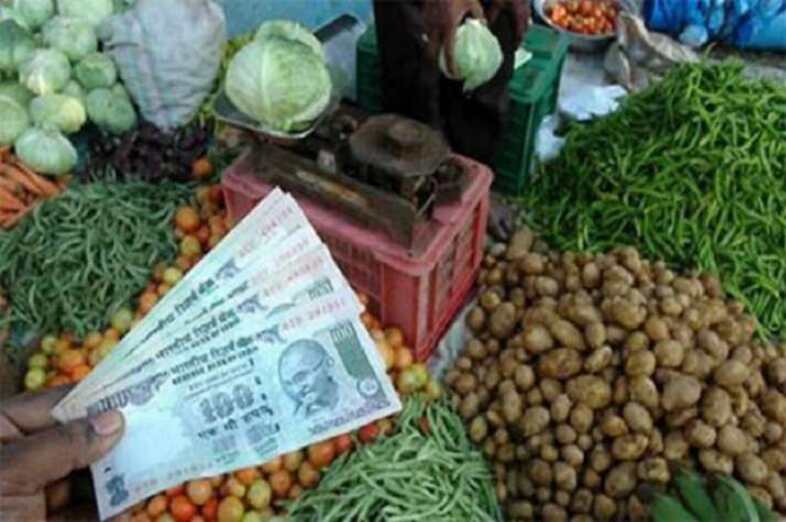Retail inflation up 4.48% in Oct

New Delhi: Retail inflation after remaining on downtrend for four months moved a tad up in October to 4.48 per cent due to an uptick in food prices and higher cost of motor fuel.
The Consumer Price Index (CPI) based inflation was 4.35 per cent in September and 7.61 per cent in October 2020.
The annual inflation had declined to 6.26 per cent in June from 6.3 per cent in May. Later it further eased to 5.59 per cent in July, 5.3 per cent in August and 4.35 per cent in September.
According to the data by the National Statistical Office (NSO), 'oils and fats' prices zoomed 33.5 per cent while inflation in the fuel and light category rose to 13.63 per cent in October 2021.
Inflation in food basket was 0.85 per cent in October, marginally up from 0.67 per cent in September. Fruit prices increased by 4.92 per cent while vegetables prices dropped by 19.43 per cent and that of eggs declined by 1.38 per cent.
Ratings firm ICRA said the uptick in the CPI inflation in October 2021 relative to the previous month, while mild, was pretty broad-based.
Hardening in inflation for clothing and footwear, and miscellaneous items suggest that reviving demand is nudging producers in some sectors to pass through the input price pressures, resulting in a pickup in the core inflation to 5.8 per cent in that month, it said.
Aditi Nayar, Chief Economist, ICRA said, "The MPC is likely to change the monetary policy stance to neutral only after there is additional evidence that the domestic demand revival has become durable, which is likely in the February 2022 review. We expect this to be accompanied by a 15 bps hike in the reverse repo rate by the RBI."
Despite base effect, still-high fuel costs, input cost pressures and seasonal turn in some food prices in coming months could even see inflation rising towards 6.2 per cent plus later in the fiscal year, Madhavi Arora, Lead Economist, Emkay Global Financial Services said.
Vegetable prices warrant monitoring given the increase in real-time data this month too. While the direct impact of the fuel price cut will be visible from November, its indirect impact in the context of pressure on producer margins, services inflation and the trajectory of oil and other commodity prices will also be important, Sreejith Balasubramanian, Economist Fund Management, IDFC AMC said.
The government has mandated the Reserve Bank to maintain retail inflation at 4 per cent with a margin of 2 per cent on the either side.
The next monetary policy of the Reserve Bank is due next month. The Reserve Bank, which mainly factors in CPI-based inflation while arriving at its bi-monthly monetary policy, has been tasked by the government to keep it at 4 per cent, with a tolerance band of 2 per cent on either side.
The RBI has projected the CPI inflation at 5.3 per cent for 2021-22: 5.1 per cent in second quarter, 4.5 per cent in third; 5.8 per cent in last quarter of the fiscal, with risks broadly balanced.
The retail inflation during April-June period of 2022-23 is projected at 5.2 per cent.
Meanwhile, Industrial production growth slips to 3.1 per cent in September, mainly due to the waning low base effect while mining and manufacturing sectors performed well.
The manufacturing sector, which constitutes 77.63 per cent of the Index of Industrial Production (IIP), grew 2.7 per cent in September, according to the data released by the National Statistical Office (NSO) on Friday.
The mining sector output rose 8.6 per cent in September, while power generation increased 0.9 per cent.
In September 2021, the IIP stood at 127.9 points compared to 124.1 points in the same month last year. The index stood at 122.9 points in September 2019, as per the NSO data.
Thus, the data showed waning of the low base effect. The IIP growth witnessed double-digit growth from May onwards this year, mainly due to the lower base effect. The data showed that industrial production recovered in September 2020 and surpassed the pre-pandemic level of September 2019. The IIP had grown by one per cent in September 2020.
Industrial production plunged 18.7 per cent in March last year following the COVID outbreak and remained in the negative zone till August 2020.
With the resumption of economic activities, factory output rose 1 per cent in September 2020 and grew 4.5 per cent in October. In November 2020, the factory output fell 1.6 per cent and then entered the positive territory with a 2.2 per cent growth in December 2020.
The IIP had recorded a contraction of 0.6 per cent and 3.2 per cent in January and February this year, respectively. In March, it grew 24.2 per cent.
For April, the NSO held back the release of complete IIP data.
In May 2021, the IIP rose 27.6 per cent, and in June, it grew 13.8 per cent.
The factory output grew 11.5 per cent in July and 12 per cent in August this year.
The second wave of the pandemic started in the middle of April this year, and many states imposed restrictions to curb the spread of coronavirus infections.
"The growth rates over the corresponding period of the previous year are to be interpreted considering the unusual circumstances on account of COVID-19 pandemic since March 2020," the NSO said in the statement.
The government had imposed a nationwide lockdown to contain the spread of coronavirus infections on March 25, 2020.
The manufacturing sector had recorded a growth of 0.4 per cent in September 2020. The mining sector output grew 1.4 per cent in the same month.
The electricity generation had grown by 4.9 per cent in September 2020.
The output of capital goods, which is a barometer of investment, grew 1.3 per cent in September 2021. It had witnessed a contraction of 1.2 per cent in the year-ago period.



